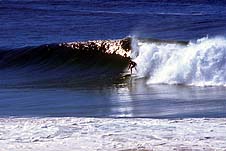
|
| Surfing on the NSW North
Coast |
Fingal Head
Pleasant coastal resort near the larger Tweed
Heads-Coolangatta complex
Fingal Head is a small fishing village come holiday resort
which lies just one kilometre south of New South Wales
border, 874 km from Sydney. It consists of a narrow spit of
land that lies between the Tweed River estuary and the
ocean. In fact, the northern tip of Fingal Head forms the
south head of the river mouth. Access is via Fingal Rd which
heads off the highway at the south-eastern edge of Tweed
Heads, just before you cross the bridge over the Tweed
River.
The traditional inhabitants of the area were the
Minjungbal people who settled more or less permanently due
to the plentiful supply of food and water. They met with
other tribes on an annual basis at Bunya Mountain (north of
what is now Brisbane) to hold corroborees. The impact of
white settlement was such that they had virtually died out
by the end of the 19th century.
Captain James Cook sailed up the Gold Coast in 1770. He
was nearly shipwrecked on Cudgen Headland and thus chose the
expressive names of Mount Warning and Point Danger for two
local landmarks.
John Oxley encountered the estuary in 1823 while scouting
out a suitable spot for a penal colony. His party took
shelter during a storm in the lea of the 10-acre islet off
Fingal Head. Two men from his party investigated the island
where they found turtles and an unidentified wreck. Thus
Oxley called it Turtle Island and named the river after a
waterway in northern England. In 1828 Captain Rous surveyed
the river, travelling about 36 km upstream. His charts
describe the islet as 'Cook's Isle' by which name it is
still known.
A military post existed briefly (1828-29) at Point Danger
on the other side of the Tweed River estuary. It was set up
to intercept escapees from the new penal settlement at
Moreton Bay.
Timbergetters worked the riverbanks for cedar from about
1844. They encountered hostility from the Minjungbal but the
gun proved mightier than the spear. Logs were floated along
the creeks and the river to the estuary although the bar
rendered shipping hazardous until a breakwater was built in
1902. 25 men and three women were recorded as living on the
Tweed in 1846.
The first permanent settlement emerged at near the
estuary in what is now
Tweed Heads South. Here the cedar-getters rendezvoused
with the schooners that brought supplies and took the logs
off to Sydney . The first European birth occurred in 1851. A
lighthouse was built at Fingal Head in 1878 and it is still
operating.
Today Fingal Head is a classic holiday resort destination
noted for its holiday activities like boating, rock fishing
and surf fishing, golfing, swimming, tennis and surfing.
Fingal Beach is recognised as an excellent surfing
destination and is remarkably peaceful in comparison to the
busy beaches which lie to the north of the Tweed River
estuary.
Things to see:
Fingal Lighthouse
Fingal lighthouse dates from 1878 and was electrified in
1980. Designed by James Barnet it stands at the southern end
of Fingal Beach. From the cliff-edge it is possible to see
an outcrop of columnar-jointed basalt called the 'Giant's
Causeway' which is named after a similar natural feature
associated either with a locality called Fingal in Northern
Ireland or Fingal Cave on the Scottish Island of Staffa,
depending on which source you believe. At any rate Fingal
was the name of a mythological Celtic giant who tried to
build a causeway over the ocean.
Cook Island
500 metres offshore is Cook Island which is a breeding
habitat for wedge-tailed shearwaters and the crested tern.
In 1823 John Oxley and his party took shelter during a storm
in the lea of the 10-acre islet. Two men from his party
investigated the island where they found turtles and an
unidentified wreck. Oxley called it Turtle Island. In 1828
Captain Rous conducted the first survey of the Tweed River
and gave the island its present name.
Recreation and Foreshore Areas
There are picnic, barbecue and childrens' play facilities at
Fingal Beach Park (north of the lighthouse and adjacent the
beach) and at Fingal Boat Harbour Park on Fingal Rd near
Wommin Lagoon. The latter also has a boat ramp.
At the northernmost point of Fingal Head (via Letitia Rd)
is South Head, which constitutes the end point of a lengthy
beach which runs along the ocean shore. Just behind South
Head, on the Tweed River's southern shore, is tiny Doppys
Beach, and just behind it is Letitia Spit, which ends at
Kerosene Inlet.

Broadwalk
Business Brokers
Broadwalk Business
Brokers specialise in General Businesses for Sale, Caravan Parks for
Sale, Motels for Sale, Management Rights & Resorts for Sale, Farms for
Sale, Hotels for sale,Commercial & Industrial Properties for Sale.
Phone:
1300 136 559
Email:
enquiries@broadwalkbusinessbrokers.com.au
AUSTRALIAN BUSINESSES FOR SALE
COFFS HARBOUR BUSINESS BROKERS
BROADWALK BUSINESS BROKERS
GOLD COAST BUSINESSES FOR SALE
BRISBANE BUSINESSES FOR SALE
SYDNEY BUSINESSES FOR SALE
CARAVAN PARKS FOR SALE
BUSINESSES FOR SALE
MOTELS
FOR SALE
HOTELS
FOR SALE
Disclaimer
We advise prospective purchasers that we take no
responsibility for the accuracy of any information in the business
provided by vendors or their professional advisers and that they should
make their own enquiries as to the accuracy of this information,
including obtaining independent legal and/or accounting advice
Fingal Head

